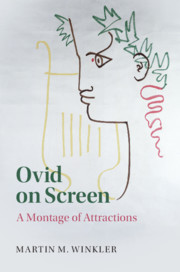Book contents
- Ovid on Screen
- Ovid on Screen
- Copyright page
- Dedication
- Contents
- Illustrations
- Acknowledgments
- D M
- Adages
- Fade-In: Prooemium
- Part I Theory and Practice
- Part II Key Moments in Ovidian Film History
- Part III Into New Bodies
- Part IV Love, Seduction, Death
- Part V Eternal Returns
- Sphragis: End Credits
- Bibliography
- Passages of Ovid’s Works
- General Index
- Plate Section (PDF Only)
Sphragis: End Credits
Published online by Cambridge University Press: 27 January 2020
- Ovid on Screen
- Ovid on Screen
- Copyright page
- Dedication
- Contents
- Illustrations
- Acknowledgments
- D M
- Adages
- Fade-In: Prooemium
- Part I Theory and Practice
- Part II Key Moments in Ovidian Film History
- Part III Into New Bodies
- Part IV Love, Seduction, Death
- Part V Eternal Returns
- Sphragis: End Credits
- Bibliography
- Passages of Ovid’s Works
- General Index
- Plate Section (PDF Only)
Summary
American essayist, novelist, and screenwriter Joan Didion once observed: “We tell ourselves stories in order to live.”1 If we broaden her idea to include storytelling to others, then Ovid’s claim in the last word of the Metamorphoses (15.879) fully applies: vivam – “I shall live.”2 In the preceding line Ovid had prepared this point: ore legar populi (“people will read me”). In this way an ancient author appended a seal – in Greek, sphragis – to his work. Today a great filmmaker could say: “People will watch my films” – or, in not quite Ovidian (because unmetrical) Latin: oculis spectabor populi.
- Type
- Chapter
- Information
- Ovid on ScreenA Montage of Attractions, pp. 384 - 390Publisher: Cambridge University PressPrint publication year: 2020

